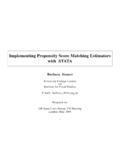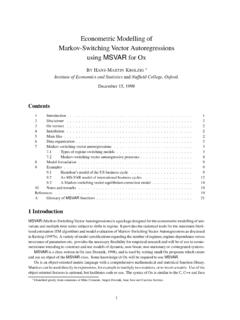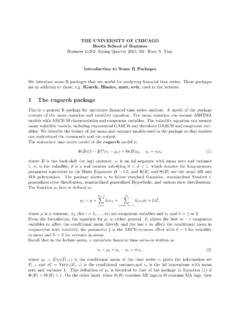Transcription of EC 823: Applied Econometrics - Boston College
1 generalized linear models Christopher F Baum ec 823 : Applied Econometrics Boston College , Spring 2013. Christopher F Baum (BC / DIW) generalized linear models Boston College , Spring 2013 1 / 25. Introduction to generalized linear models Introduction to generalized linear models The generalized linear model (GLM) framework of McCullaugh and Nelder (1989) is common in Applied work in biostatistics, but has not been widely Applied in Econometrics . It offers many advantages, and should be more widely known. GLM estimators are maximum likelihood estimators that are based on a density in the linear exponential family (LEF). These include the normal (Gaussian) and inverse Gaussian for continuous data, Poisson and negative binomial for count data, Bernoulli for binary data (including logit and probit) and Gamma for duration data. Christopher F Baum (BC / DIW) generalized linear models Boston College , Spring 2013 2 / 25. Introduction to generalized linear models GLM estimators are essentially generalizations of nonlinear least squares, and as such are optimal for a nonlinear regression model with homoskedastic additive errors.
2 They are also appropriate for other types of data which exhibit intrinsic heteroskedasticity where there is a rationale for modeling the heteroskedasticity. The GLM estimator maximizes the log-likelihood N. X. Q( ) = [a (m(xi , )) + b(yi ) + c (m(xi , ))]. i=1. where m(x, ) = E(y |x) is the conditional mean of y , a( ) and c( ). correspond to different members of the LEF, and b( ) is a normalizing constant. Christopher F Baum (BC / DIW) generalized linear models Boston College , Spring 2013 3 / 25. Introduction to generalized linear models For instance, for the Poisson, where the mean equals the variance, a( ) = and c( ) = log( ). Given definitions of these two functions, the mean and variance are E(y ) = = a0 ( )/c 0 ( ) and Var (y ) = 1/c 0 ( ). For the Poisson, a0 ( ) = 1, c 0 ( ) = 1/ , so E(y ) = Var (y ) = . GLM estimators are consistent provided that the conditional mean function is correctly specified: that E(yi |xi ) = m(xi , ). If the variance function is not correctly specified, a robust estimate of the VCE should be used.
3 Christopher F Baum (BC / DIW) generalized linear models Boston College , Spring 2013 4 / 25. Introduction to generalized linear models To use the GLM estimator, you must specify two options: the family(), which defines the member of the LEF to be employed, and the link(), which is the inverse of the conditional mean function. The family option may be chosen as gaussian, igaussian, binomial, poisson, binomial, gamma. The link function essentially expresses the transformation to be Applied to the dependent variable. Each family has a canonical link, which is chosen if not specified: for instance, family(gaussian) has default link(identity), so that a GLM with those two options would essentially be linear regression via maximum likelihood. The binomial family has a default link(logit), while the poisson and binomial families share link(log). However, a number of other combinations of family and link are valid: for instance, link(power n) is valid for all distributional families. Christopher F Baum (BC / DIW) generalized linear models Boston College , Spring 2013 5 / 25.
4 Some applications Fractional logit model Some applications As an illustration of the GLM methodology, consider a model in which we seek to explain a ratio variable, such as a firm's ratio of R&D. expenditures to total assets. In micro data, we find that many firms report a zero value for this ratio. A linear regression model would ignore the zero lower bound, and would not take account of managers'. decision not to engage in R&D activity. Much of the empirical research in this area has made use of a Tobit model, which combines the Probit likelihood that a zero value will be observed with the linear regression likelihood to explain non-zero values, and a Tobit approach certainly improves upon standard linear regression by taking account of the mass point at zero. Christopher F Baum (BC / DIW) generalized linear models Boston College , Spring 2013 6 / 25. Some applications Fractional logit model However, some researchers ( , Papke and Wooldridge, J. Appl. Econometrics , 1996) have argued that the Tobit model, a censored regression technique, is not applicable where values beyond the censoring point are infeasible.
5 The motivation for Tobit is often that of an underlying latent variable, such as consumer utility, which is observed only in a limited range: for instance, those deriving positive expected utility from a purchase are observed spending that amount, while those with negative expected utility do not purchase the item. That latent variable interpretation is difficult to motivate in the R&D expenditure setting. Christopher F Baum (BC / DIW) generalized linear models Boston College , Spring 2013 7 / 25. Some applications Fractional logit model Papke and Wooldridge suggest that a GLM with a binomial distribution and a logit link function, which they term the fractional logit' model, may be appropriate even in the case where the observed variable is continuous. To model the ratio y as a function of covariates x, we may write g{E(y )} = x , y F. where g( ) is the link function and F is the distributional family. In our case, this becomes logit{E(y )} = x , y Bernoulli which should be estimated with a robust VCE.
6 Christopher F Baum (BC / DIW) generalized linear models Boston College , Spring 2013 8 / 25. Some applications Fractional logit model We illustrate with proportions data in which both 0 and 1 are observed, first fitting with a Tobit specification: . use , clear . g proportion = menarche/total . tobit proportion age, ll(0) ul(1) vsquish Tobit regression Number of obs = 25. LR chi2(1) = Prob > chi2 = Log likelihood = Pseudo R2 = proportion Coef. Std. Err. t P>|t| [95% Conf. Interval]. age .2336978 .0108854 .2112314 .2561642. _cons .1454744 /sigma .0780817 .0119052 .0535105 .1026528. Obs. summary: 3 left-censored observations at proportion<=0. 21 uncensored observations 1 right-censored observation at proportion>=1. Christopher F Baum (BC / DIW) generalized linear models Boston College , Spring 2013 9 / 25. Some applications Fractional logit model As Papke and Wooldridge's critique centers on the interpretation of the dependent variable, we might want to make use of Stata's linktest, a specification test that considers whether the link' is appropriate.
7 In the link test, we regress the dependent variable on the predicted values and their squares. If the model is specified correctly, the squares of the predicted values will have no power. Christopher F Baum (BC / DIW) generalized linear models Boston College , Spring 2013 10 / 25. Some applications Fractional logit model . linktest, ll(0) ul(1) vsquish Tobit regression Number of obs = 25. LR chi2(2) = Prob > chi2 = Log likelihood = Pseudo R2 = proportion Coef. Std. Err. t P>|t| [95% Conf. Interval]. _hat .1440383 _hatsq .123241 _cons .0351176 /sigma .0640866 .0098612 .0436872 .0844859. Obs. summary: 3 left-censored observations at proportion<=0. 21 uncensored observations 1 right-censored observation at proportion>=1. As is evident, the link test rejects its null, and casts doubt on the Tobit specification. Christopher F Baum (BC / DIW) generalized linear models Boston College , Spring 2013 11 / 25. Some applications Fractional logit model Let us reestimate the model with a fractional logit GLM.
8 Glm proportion age, family(binomial) link(logit) robust nolog note: proportion has noninteger values generalized linear models No. of obs = 25. Optimization : ML Residual df = 23. Scale parameter = 1. Deviance = .221432 (1/df) Deviance = .0096275. Pearson = .1874651097 (1/df) Pearson = .0081507. Variance function: V(u) = u*(1-u/1) [Binomial]. Link function : g(u) = ln(u/(1-u)) [Logit]. AIC = .5990425. Log pseudolikelihood = BIC = Robust proportion Coef. Std. Err. z P>|z| [95% Conf. Interval]. age .0541201 _cons .7047346 . qui margins, at(age=(10(1)18)).. marginsplot, addplot(scatter proportion age, msize(small) ylab(,angle(0))) //. > /. > ti("Proportion reaching menarche") legend(off). Variables that uniquely identify margins: age Christopher F Baum (BC / DIW) generalized linear models Boston College , Spring 2013 12 / 25. Some applications Fractional logit model The link function now is satisfied with the specification: . linktest, robust vsquish Iteration 0: log pseudolikelihood = generalized linear models No.
9 Of obs = 25. Optimization : ML Residual df = 22. Scale parameter = .016672. Deviance = .3667845044 (1/df) Deviance = .016672. Pearson = .3667845044 (1/df) Pearson = .016672. Variance function: V(u) = 1 [Gaussian]. Link function : g(u) = u [Identity]. AIC = Log pseudolikelihood = BIC = Robust proportion Coef. Std. Err. z P>|z| [95% Conf. Interval]. _hat .1173394 .0114055 .0949851 .1396938. _hatsq .0036441 .0041182. _cons .524775 .0337826 .4585623 .5909878. Christopher F Baum (BC / DIW) generalized linear models Boston College , Spring 2013 13 / 25. Some applications Fractional logit model We may also plot the predictions of the GLM model against the actual proportions data: Proportion reaching menarche 1..8. Predicted Mean Proportion .6..4..2. 0. 10 11 12 13 14 15 16 17 18. age Christopher F Baum (BC / DIW) generalized linear models Boston College , Spring 2013 14 / 25. Some applications Log-gamma model Log-gamma model Consider a situation where a GLM approach might be useful in simplifying the interpretation of an estimated model.
10 Say that an outcome variable is strictly positive, and we want to model it in a nonlinear form. A common approach would be to transform the outcome variable with logarithms. This raises the issue that the predictions of the model in levels are biased, even when adjustments are made for the retransformation bias' (see sec describe levpredict). Christopher F Baum (BC / DIW) generalized linear models Boston College , Spring 2013 15 / 25. Some applications Log-gamma model Alternatively, we can address this problem by using a log-gamma GLM, with the family chosen as gamma and the link function specified as the log. The predictions, residuals and other regression diagnostics of the model are then kept in the natural units of measurement, which may make estimation of the model in this context more attractive than estimating the log-linear regression model. Christopher F Baum (BC / DIW) generalized linear models Boston College , Spring 2013 16 / 25. Some applications Log-gamma model . sysuse cancer (Patient Survival in Drug Trial).










